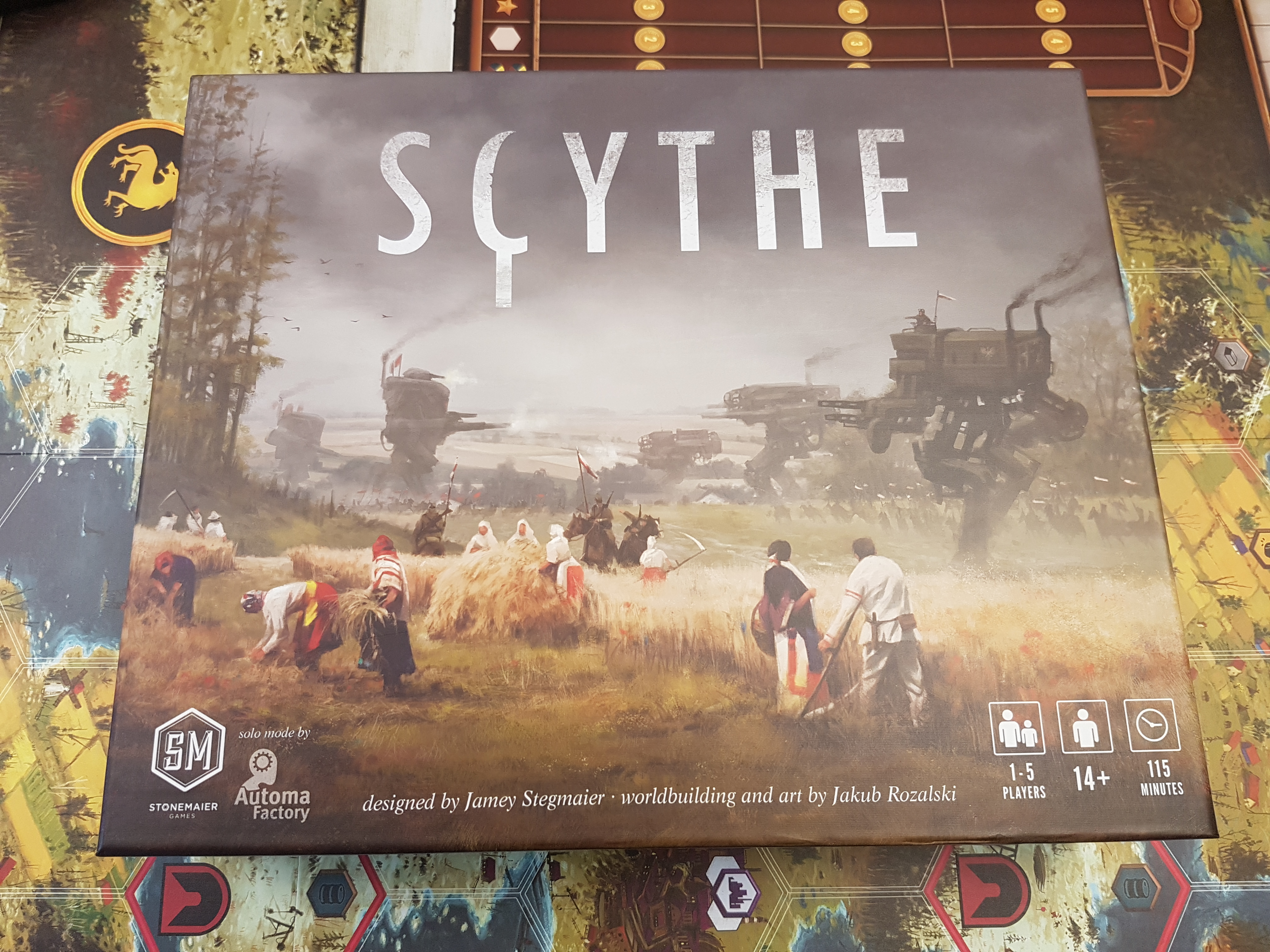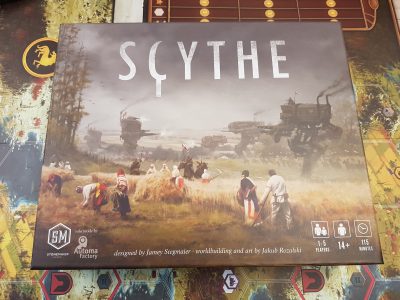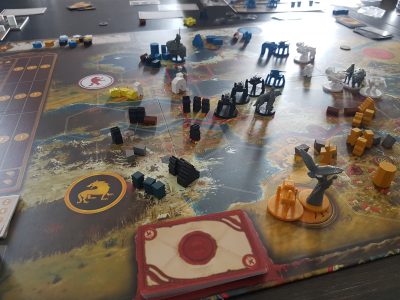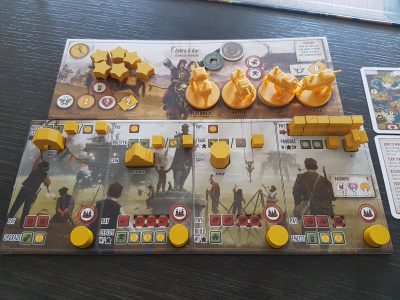Scythe is an engine building board game from Stonemaier Games. Set in an alternative history styled 1920s the game takes place after a great war, leaving mechs in the hands of factions trying to claim fortunes for themselves. Jamey Stegmaier, the man behind Viticulture, Euphoria and their expansions, returned with a new game in October of 2015. Since, Scythe has seen one expansion release, Invaders from Afar, and another one is in the works for later this year, The Wind Gambit. Today, we’re looking at the base game on its own and in all its glory.
This is just a quick overview of the key feature and mechanisms that make Scythe a wonderful experience to participate in. An experience that isn’t tarnished whether you win or drastically lose, get battered in combat, have resources stolen or have worker run out of their lands. Scythe is thought of as a medium to heavy game. In reality, it is just a combination of a lot of simple rules, which are intuitive and make sense within the setting of the game world.
A game of Scythe lasts until a single player places all 6 stars on the victory tracker. Aside from a couple of “in case” rules, the instant someone does an action that earns them a sixth star the game ends, yet they may not be the winner. In the only game where I came out victorious (a pitiful attempt out of 10 games…) I only had 4 stars when the game ended. Coins are the real victory point commodity in Scythe. Stars along with the placement of buildings plus controlling tiles and resources at the conclusion of the game all add together to gain individual players coins. Even the popularity of your faction, which is spent like any other commodity in a game, is utilized as a multiplier when collecting coins in the post-game scoring.
Players have a choice of 4 main actions to choose from. By default they are not able to choose the same action two turns in a row, adding an element of increased planning. Each has multiple options in the form of Top and Bottom row actions. The 4 Top Row actions are Move/Gain, Trade, Produce and Bolster, these actions are identical on each player board. The Bottom row actions, Deploy, Enlist, Build and Upgrade, are similar. These offer the same main action but come with differing costs and varying benefits. To mix things up slightly, whilst maintaining balance, each action board has different combinations of the Top and Bottom row actions. On top of this, action boards are randomly assigned to players independent of factions.
On a given turn a player moves their turn piece to one of the four quarters of their player board and can then do either the Top row action, the Bottom row action, the Top then Bottom row actions or neither. Once done it is straight on with the next players turn, unless Encounters or Combat have been triggered. As an example player A could decide to Bolster gaining two power for combat and be unable to complete the bottom row action Upgrade, where paying 3 Oil would gain them 1 Upgrade and 3 Coins. Player B then decides to use the Move actions to march their player character into a hex which contains Player C’s player character and a worker unit. Player B now can now either do the bottom row action of Build or conclude his/her turn and resolve the combat.
In combat the two players take Power Dials and secretly spend up to 7 Power, which also limited by the amount they have, by setting the dial to a number. For each military unit, made from plastic, they can select one of their Combat Cards to add to the Power Dials score. Once both Player B & C have set their Dials and chosen a Combat Card both players reveal their Dials and the combat is resolved. The highest power score wins, with attackers winning ties. The loser returns all of his units, both plastic and wooden to his home base, but gains a Combat Card if any Power was spent. The winner gains a combat victory star, by default factions can only gain two stars in this way. They also lose one popularity for every wooden worker unit they have forced back to their home base.
The design of Scythe, with nine unique ways to score stars, means almost anything can work. Strategies can vary massively in the same game and multiple players can end the game extremely close in terms of points. Factions only majorly vary when it comes to the faction boards. These offer a unique faction ability, often based around a player being able to bypass a normal rule. The Saxony Empire for instance have a special ability to score stars for addition military victories after the standard two. This would suggest that a Saxony player should concentrate on getting mechs onto the map to overwhelm the other players with military might but it isn’t always the case. The Saxony ability also allows the player to score multiple stars from objectives offering more than one route.
Each faction has 4 mech and character abilities they can unlock by deploying mechs. Saxony for instance has an ability called Underpass. If the mech usually covering the Underpass ability is in play all mechs and the player character gain that ability. This enables the Saxony player to move units from controlled tiles with a metal symbol on them to others in their control or mines. This ability that goes hand in hand with moving military units around the board quickly. Although, the movement can instead be utilized to get to Encounters first, spread out workers across the board faster to gain resources or even to move workers into key tiles to force opponents to lose popularity. Lowering the popularity of opponents at the right time can see their final scores being drastically cut, but only if done at the correct time so they cannot react before the game is over. Some strategies will work even when it doesn’t seem to initially offer a harmonious plan.




